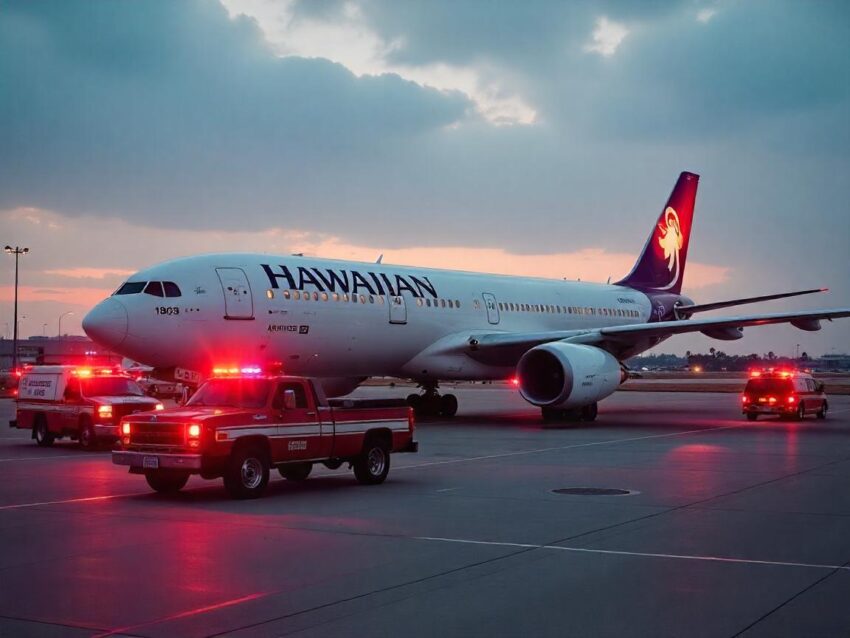- by foxnews
- 01 Jun 2025
Hawaiian Airlines Bomb Threat Forces Emergency Evacuation of Two Hundred and Eighty Three Passengers at San Diego Airport, Disrupting Hundreds of Travel Plans to Honolulu, What You Must Know
Panic struck without warning. A routine flight turned into a nightmare as a Hawaiian Airlines jet with Two Hundred and Eighty Three Passengers faced a chilling bomb threat at San Diego Airport. The calm morning air quickly gave way to chaos, with flashing sirens and sudden orders. A full emergency evacuation unfolded on the tarmac, jolting passengers who were just moments away from their tropical escape to Honolulu. The threat wasn’t just a whisper—it was loud enough to halt everything. Hawaiian Airlines flight crews acted instantly. The emergency evacuation began, and what should’ve been a serene journey to Honolulu turned into fear, confusion, and disrupted dreams. Meanwhile, San Diego Airport shifted into crisis mode.
- by travelandtourworld
- 21 May 2025
- in travel

And the worst part? No one saw it coming.
Why did this Hawaiian Airlines with Two Hundred and Eighty Three Passengers flight become the center of a San Diego Airport security lockdown? What led to the terrifying emergency evacuation? And how did it impact those headed to Honolulu with dreams of paradise?
The situation unfolded in minutes. The fallout could echo for days.
A calm Tuesday morning at San Diego International Airport (SAN) quickly turned tense and chaotic when a Hawaiian Airlines flight destined for Honolulu was evacuated due to a bomb threat, disrupting travel for nearly 300 passengers and rattling the travel industry.
The incident occurred just after 8:30 a.m. on May 20, 2025, moments after the Airbus A330 had pushed back from its gate. What began as a routine departure spiraled into a full-scale emergency that demanded the attention of local and federal law enforcement.
As the aircraft began its taxi toward the runway, one of the passengers allegedly made a verbal threat concerning the safety of the plane. The crew responded swiftly and decisively.
By 10:30 a.m., all 283 passengers and 10 crew members had been safely evacuated. Emergency vehicles lined the tarmac. Sirens blared. Passengers exited under tense but orderly conditions, their Hawaiian vacation plans now uncertain.
The aircraft was isolated. The area was swept. K-9 units inspected every inch of the jet. Law enforcement combed through passenger belongings. Meanwhile, authorities worked quickly to identify the individual responsible for the threat.
The airport itself remained operational. According to airport officials, no other flights were impacted and all terminals continued functioning normally, thanks to the containment efforts made by ground staff.
While no explosive device was found, the emotional shockwaves rippled far beyond the tarmac.
Even after the all-clear was given, the psychological aftermath remained. Passengers were rebooked, but the sense of security many associate with air travel had been temporarily broken.
Hawaiian Airlines worked quickly behind the scenes to minimize further disruption. The airline began the rebooking process and initiated logistical support for affected passengers, including meal vouchers, alternate flights, and communications assistance.
Travelers were promised rerouting to Daniel K. Inouye International Airport (HNL) as soon as possible. Many were re-accommodated on the next available flights, with additional staff deployed to assist with the sudden surge in customer service needs.
This incident comes at a time when air traffic is nearing pre-pandemic levels. Airlines, airports, and security agencies are grappling with how to balance passenger flow with thorough safety screening.
Although the threat was ultimately unsubstantiated, the fact that a verbal statement alone could derail operations for hundreds speaks volumes. The aviation industry must now reassess the protocols surrounding threat assessment, in-flight incident response, and post-event passenger care.
Moreover, stakeholders will likely examine how such events impact traveler confidence, especially in destinations like Hawaii, where tourism remains the backbone of the economy.
Bomb threats, unruly passenger behavior, and mid-flight medical emergencies are becoming increasingly common headlines in global aviation. While rare, such incidents emphasize the fragile stability of large-scale air operations.
Disruptions not only delay flights but can impact airport efficiency, gate allocations, and crew rest scheduling. For a busy hub like San Diego, even a single incident like this can cause downstream scheduling chaos across multiple airlines.
Travel industry analysts are now looking closely at how these security challenges influence consumer sentiment, airline operations, and policy development.
As this story unfolds and the industry learns from it, one thing is clear: every minute counts, and every word spoken on a plane matters.
This was not just a false alarm. It was a signal. A test. And perhaps, a much-needed push toward improving how we all navigate the skies ahead.
Source: fox5sandiego
- by foxnews
- descember 09, 2016
Beach days benefit mental health and well-being as visits provide 'sea therapy'
Discover the benefits of sea therapy as experts highlight how beach visits can boost mental well-being, reduce stress and improve sleep through mindfulness and relaxation.
read more




